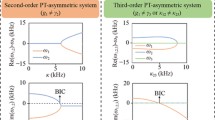Abstract
This paper evaluates the performance of a wireless powered communications system, where an energy-aware relay can ability of controlling proper energy harvesting parameters for obtaining maximal throughput. Considering a power splitting approach, the relay first can calculate percentage of harvested wireless energy from power supply source, and then transmits information to the destination. This paper proposes the dynamic harvesting power allocation policy for energy harvesting and analytical expressions for the delay-limited and delay-tolerant throughput related to amplify-and-forward relaying mode. In particular, the optimal power coefficients can be derived in closed-form expressions, in which the maximal throughput can be obtained in special case, i.e., high transmit power regime. In addition, the impact of transmit power, power splitting fraction, the fixed rate factors, noise levels are well studied. Simulation results validate the theoretical expressions and show the effectiveness of the proposed policy.







Similar content being viewed by others
References
Nasir, A. A., Zhou, X., Durrani, S., & Kennedy, R. (2013). Relaying protocols for wireless energy harvesting and information processing. IEEE Transactions on Wireless Communications, 12(7), 3622–3636.
Krikidis, I., Timotheou, S., & Sasaki, S. (2012). RF energy transfer for cooperative networks: Data relaying or energy harvesting? IEEE Communications Letters, 16(11), 1772–1775.
Ding, Z., & Poor, H. V. (2013). Cooperative energy harvesting networks with spatially random users. IEEE Signal Processing Letters, 20(12), 1211–1214.
Nguyen, X.-X., & Do, D.-T. (2017). Optimal power allocation and throughput performance of full-duplex DF relaying networks with wireless power transfer-aware channel. EURASIP Journal on Wireless Communications and Networking, 2017(1), 152.
Nguyen, K. T., Do, D.-T., Nguyen, X. X., Nguyen, N. T., & Ha, D. H. (2015). Wireless information and power transfer for full duplex relaying networks: Performance analysis. In Proceedings of recent advances in electrical engineering and related sciences (AETA 2015) (pp. 53–62), HCMC, Vietnam.
Do, D.-T., Nguyen, H.-S., Vozk, M., & Nguyen, T.-S. (2017). Wireless powered relaying networks under imperfect channel state information: System performance and optimal policy for instantaneous rate. Radioengineering, 26(3), 869–877.
Chen, H., Li, Y., Rebelatto, J. L., Uchoa-Filho, B. F., & Vucetic, B. (2015). Harvest-then-cooperate: Wireless-powered cooperative communications. IEEE Transactions on Signal Processing, 63(7), 1700–1711.
Zhu, G., Zhong, C., Suraweera, H. A., Karagiannidis, G. K., Zhang, Z., & Tsiftsis, T. A. (2015). Wireless information and power transfer in relay systems with multiple antennas and interference. IEEE Transactions on Communications, 63(4), 1400–1417.
Ding, H., da Costa, D. B., Liu, W.-L., & Ge, J. (2015). Enhancing cooperative diversity gains in dual-hop one-way/two-way AF relaying systems: A fully opportunistic role selection strategy. IEEE Transactions on Vehicular Technology, 64(8), 3440–3457.
Zhou, Z., Peng, M., Zhao, Z., & Li, Y. (2015). Joint power splitting and antenna selection in energy harvesting relay channels. IEEE Signal Processing Letters, 22(7), 823–827.
Minasian, A., Shahbaz Panahi, S., & Adve, R. S. (2014). Energy harvesting cooperative communication systems. IEEE Transactions on Wireless Communications, 13(11), 6118–6131. Nov.
Chen, H., Li, Y., Jiang, Y., Ma, Y., & Vucetic, B. (2015). Distributed power splitting for SWIPT in relay interference channels using game theory. IEEE Transactions on Wireless Communications, 14, 410–420.
Ho, C. K., & Zhang, R. (2010). Optimal energy allocation for wireless communications powered by energy harvesters. In Proceedings of 2010 IEEE international symposium on information theory proceedings (pp. 2368 –2372) (ISIT)
Ozel, O., Tutuncuoglu, K., Yang, J., Ulukus, S., & Yener, A. (2011). Transmission with energy harvesting nodes in fading wireless channels: Optimal policies. IEEE Journal on Selected Areas in Communications, 29(8), 1732–1743.
Huang, C., Zhang, R., & Cui, S. (2011). Throughput maximization for the Gaussian relay channel with energy harvesting constraints. CoRR, ArXiv:abs/1109.0724
Gurakan, B., Ozel, O., Yang, J., & Ulukus, S. (2012). Energy cooperation in energy harvesting wireless communications. In Proceedings of 2010 IEEE international symposium on information theory proceedings (pp. 965–969) (ISIT)
Do, D.-T. (2015). Energy-aware two-way relaying networks under imperfect hardware: Optimal throughput design and analysis. Telecommunication Systems Journal (Springer), 62(2), 449–459.
Do, D.-T. (2016). Optimal throughput under time power switching based relaying protocol in energy harvesting cooperative network. Wireless Personal Communications (Springer), 87(2), 551–564.
Nguyen, T. N., Do, D.-T., Tran, P. T., & Voznak, M. (2016). Time switching for wireless communications with full-duplex relaying in imperfect CSI condition. KSII Transactions on Internet and Information Systems, 10(9), 4223–4239.
Author information
Authors and Affiliations
Corresponding author
Additional information
Publisher’s Note
Springer Nature remains neutral with regard to jurisdictional claims in published maps and institutional affiliations.
Appendix
Appendix
Proof of Proposition 2
The outage probability can be computed by
where \(L={\beta \eta \left| g \right| ^2 d_1^m \sigma _R^2 + d_1^m d_2^m \sigma _D^2 \left( {1 - \beta } \right) }\). It can be re-expressed by
in which \(h_1\) and \(h_2\) are outcomes of the function below
and \(h_1\) and \(h_2\) are determined by
where
Due to \(h_1 <0\), the given outage probability can be rewritten as
Thus, we obtain new expression as
This is end of Proof of Proposition 2 by averaging value of channel gain of h.
Rights and permissions
About this article
Cite this article
Do, DT. Optimal Energy Harvesting Strategy in Relaying Networks: Dynamic Allocation Scheme and Performance Analysis. Wireless Pers Commun 108, 1097–1111 (2019). https://doi.org/10.1007/s11277-019-06456-1
Published:
Issue Date:
DOI: https://doi.org/10.1007/s11277-019-06456-1




